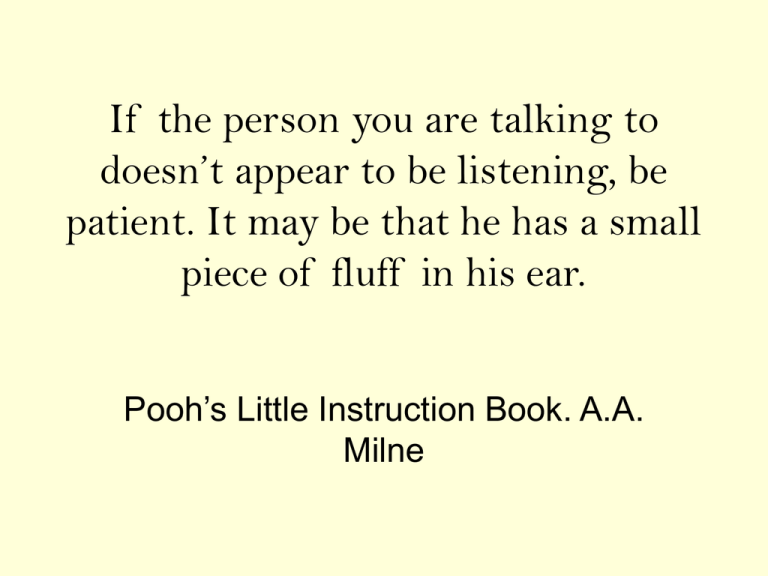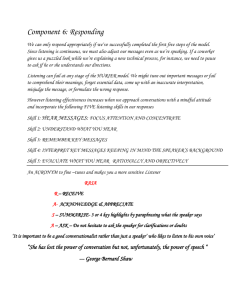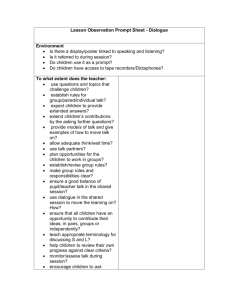Active Listening Skills (Kathy)
advertisement

If the person you are talking to doesn’t appear to be listening, be patient. It may be that he has a small piece of fluff in his ear. Pooh’s Little Instruction Book. A.A. Milne Effective Listening Listening is one of the most important elements of effective communication but it is also the most neglected. Why Don’t We Listen? Listening Awareness Inventory What type of listener are you? NTAC Family Feud! How many words a minute does the average person speak? 130 words per minute How many words a minute can the average person listen to ? 400 to 500 words per minute. We spend up to 80% of our conscious time using the four basic communication skills: writing, reading, speaking and listening. How much of this time is spent on listening? 40% of our conscious time is spent listening What percentage of information do we usually recall immediately after we listen to someone talk? We recall approximately 50%. What percentage of what we hear do we remember overtime? Overtime, we remember less than 2%. True or False: Listening is a learned skill? True – listening is a learned skill. In the “Art of Listening” Frances Hesselbein wrote “but is nobody’s friend – listener or speaker. What word does she recommend we use instead of but. The word and. True or False: Body language is not part of active listening? False. Body language is a very important component to active listening. What part of the body should be used the most when engaged in active listening? The face. True or False: Listening to the radio can improve your active listening skills? False. Listening to the radio is an example of passive listening. True or False: According to the Dolittle Method of Listening turkey’s are odd-ball communicators who are unorganized and whose feathers ruffle easily. True. Turkeys are odd-ball communicators. True or False: Communication is a product of culture. True. The way a person communicates emanates form his or her culture. When Abraham Lincoln was getting ready to reason with a man, what percentage of his time was spent thinking about what he was going to say and what percentage spent thinking about what the other person would say? 1/3 of the time on himself; 2/3 of the time on the other person. What is Active Listening? • Verbal and non-verbal feedback to the speaker about your understanding of what is being communicated. • Thinking and acting in a way that connects you with the speaker. Acceptance Response Purpose: To convey interest; provide verbal or non-verbal awareness of the speaker. Action: Insert simple verbal utterances or words into the conversation; use non-verbal communication too. Example: Good eye contact, gesture, facial expression, eye gaze, posture, etc. “I see,” “ Go on”, “Yes,”. Repeating Purpose: To indicate to speaker you have identified critical components of the message. Action: Highlight key words or phrases verbatim. Example: Speaker: I will be only be available during the day on the 9th, 10th & 11th. Listener; (tone of expectation of additional information) … the 9th, 10th and ... Paraphrasing Purpose: To show that you are listening and understanding what is being said. Action: State, in your own words, your understanding of what you heard; use fewer words to get more to the point. Examples: Speaker: I really think he is a nice guy, He’s so thoughtful, sensitive & kind & fun to go out with. Listener: So … you like him very much, then. Clarifying Purpose: To clarify speaker’s message; move the conversation from broad generalizations to specific facts; bring vague material into sharper focus; uncover new information. Action: Ask questions for additional information and to be certain you understand what is being said; restate wrong interpretation to force the speaker to explain further. Example: Listener: Let me make sure that I understand you. You sent the check in weeks ago. Do you remember what day it was mailed? Summarizing Purpose: To assure both the listener and the speaker that a complex message was received and understood. Bring discussion to closure; pull together, organize & integrate major aspects of conversation; to review progress. Action: Restate the major ideas expressed; recap after all points have been covered (do not insert new ideas when summarizing). Example: Listener: “These seem to be the key ideas you’ve expressed . . .” Reflecting Purpose: To show that you know how the person feels. Action: Reflect the speaker’s feelings; use short statements; express concern in response to strong feelings or problems expressed by speaker. Example: Listener: “You seem very upset.” Silence Purpose: To provide the speaker with the time needed to express his/her thoughts. Action: Giving the other time to think as well as talk. Feedback Purpose: To demonstrate understanding and support by sharing your feelings/reactions with the speaker. Action: Technique followed paraphrasing & clarifying. Listener shares some personal thoughts & feelings as a result of what was said. Example: Listener: “Years ago I had a similar experience & I found it very upsetting too.” Perception Checking Purpose: To check out assumptions and perceptions. Action: Ask if your assumption or perception of the situation is valid and accurate. Example: Listener: “Let me see if I have this right. You think Joan is angry with you because she didn’t say good-bye before she left the party.” Interpreting Purpose: To offer a different view or a new way to look at the problem/issue; add an additional perspective. Action: Tentatively offer a new interpretation for the situation or perspective. Example: Listener: “Another way to look at this might be Joan left the party because she wasn’t feeling well. She didn’t look well to me.” Validating Purpose: To acknowledge the worthiness of the other person. Action: Show appreciation for their efforts and actions. Example: Listener: “I truly appreciate your willingness to resolve this matter.” Benefits to Active Listening Listeners are better able to. . . • • • • • Understand problems Sustain more information Retain more information Clarify procedures Build relationships Good Listening . . . • • • • • Minimizes miscommunications Generates respect Increases productivity from better problem solving Promotes good relationships Creates safe environments Psychological Truth “When you sincerely try to understand another person’s point of view (not necessarily agree with it) then he/she becomes psychologically obligated to understand your point of view.” www.learncustomerserviceonline.com Why? “People are often unwilling to hear what you have to say in response to their situation until you acknowledge that you understand what they said. You accomplish this by simply paraphrasing or summarizing what they said to make sure that what you heard is what they intended. This establishes a psychological truth that essentially obligates the speaker to hear what you have to say.” www.learncustomerserviceonline.com





